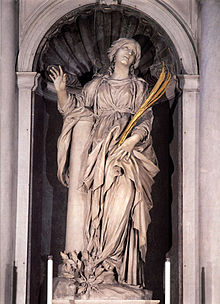Bibiana (saint)
The holy Bibiana (* around 347-352 in Rome ; † around 361 to 363 in Rome) was an early Christian virgin and martyr . Their name is derived from the Latin term vivius for the living or life Merry from. Other spellings are Vivien , Viviane or Viviana.
Legend
According to tradition, Bibiana was the daughter of Prefect Flavianus during the reign of Emperor Julian. Since Flavianus made his house available to persecuted Christians as a shelter, he and his wife Dafrosa were arrested by Emperor Julian and tortured so severely in prison that they died of these injuries a short time later. The daughters Demetria and Bibiana were expropriated and should be forced to renounce Christianity . When they did not give in, they too were imprisoned. Demetria died after being in prison for some time as a result of torture and starvation. Bibiana was also tortured for months and finally chained to a pillar of the refuge and scourged to death there . A priest buried them there.
Adoration
Pope Simplicius (468 - 483) had a church built over her grave about 100 years later, which later became the Basilica of Santa Maria Maggiore . On the Esquiline Hill near Santa Maria Maggiore is the Column of the Martyrdom of St. Bibiana, also known as Bibiana of Rome. Dust from this pillar and mint from her grave are said to help against epilepsy . In art she is portrayed as a young martyr, with a palm branch , a pillar, scourge , dagger in her chest and mint at her feet. She is considered the patron saint against epilepsy, headaches, cramps, accidents and alcoholism. The feast day of the saints is December 2nd. In the XV. Roman district, near the Roma Termini train station is the church of Santa Bibiana .
literature
- Ekkart Sauser: Bibiana (Vibiana). In: Biographisch-Bibliographisches Kirchenlexikon (BBKL). Volume 15, Bautz, Herzberg 1999, ISBN 3-88309-077-8 , Sp. 142-143.
- Lexicon of the Saints , Verlagsgruppe Weltbild GmbH, Augsburg , 2005, ISBN 3-8289-4980-0
Web links
| personal data | |
|---|---|
| SURNAME | Bibiana |
| ALTERNATIVE NAMES | Vivien; Viviane; Viviana |
| BRIEF DESCRIPTION | Martyr and saint |
| DATE OF BIRTH | at 352 |
| PLACE OF BIRTH | Rome |
| DATE OF DEATH | at 363 |
| Place of death | Rome |

